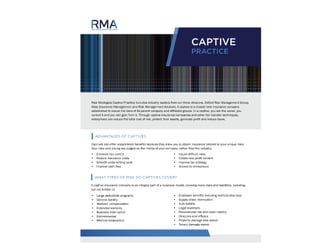
Captive insurance companies have become a popular option for businesses looking to manage their insurance risks in a more cost-effective and tailored manner. However, when it comes to underwriting, it is crucial for captive insurance companies to coordinate their underwriting needs with traditional insurance policy underwriting. This ensures that the risks and coverage are adequately assessed and aligned between the captive insurer and the traditional insurance company.
Importance of Coordinating Underwriting
Coordinating underwriting between captive insurance companies and traditional insurance policies is essential for several reasons. Firstly, it allows for a comprehensive evaluation and assessment of the risks involved. By coordinating underwriting, both the captive insurer and the traditional insurance company can collectively analyze the risk profile and assess the appropriate coverage limits. This helps in avoiding any gaps or overlaps in coverage, ensuring that all risks are adequately addressed.
Secondly, coordinating underwriting allows for accurate pricing of premiums. By considering the underwriting information from both the captive insurance company and the traditional insurance policy, a more accurate assessment of the risks can be made, leading to more appropriate premium pricing for the coverage provided. This ensures that the captives are not overpaying or underpaying for their insurance needs.
Lastly, coordinating underwriting facilitates a smoother claims process. When a claim is made, both the captive insurer and the traditional insurance company need to work together to assess the validity of the claim, determine the coverage, and process the payment. Coordinated underwriting ensures that both parties have a clear understanding of the insured risks and helps avoid any disputes or delays in the claims handling process.
Coordinating Captive and Traditional Underwriting
When it comes to insurance coverage, many businesses opt for a combination of captive insurance and traditional insurance policies to meet their risk management needs. However, it is crucial to understand that the underwriting process for captive insurance needs to be coordinated with traditional insurance policy underwriting. This coordination ensures comprehensive coverage and avoids gaps or overlaps in insurance protection.
Benefits of Coordinating Underwriting
Coordinating underwriting between captive and traditional insurance policies offers several benefits:
- Comprehensive Coverage: By coordinating underwriting, businesses can ensure that all potential risks are adequately covered. Traditional insurance policies provide coverage for standard risks, while captive insurance allows businesses to tailor coverage to their unique needs. Coordinating underwriting ensures that there are no gaps in coverage and all risks are accounted for.
- Cost Efficiency: By combining captive insurance and traditional insurance policies, businesses can optimize their risk management costs. Traditional insurance policies cover common risks that can be purchased at competitive market rates, while captive insurance covers specialized or higher-risk areas. Coordinating underwriting allows businesses to minimize insurance costs while maintaining comprehensive coverage.
Challenges in Coordinating Underwriting
Coordinating underwriting between captive and traditional insurance policies may present some challenges:
- Complex Underwriting Process: Coordinating underwriting requires a detailed understanding of both captive insurance and traditional insurance policies. It may involve different underwriting criteria, documentation, and risk assessment processes. Coordinating these aspects can be complex and time-consuming.
- Alignment of Coverage: Coordinating underwriting requires aligning the coverage provided by captive insurance and traditional insurance policies. This may involve adjusting limits, deductibles, and policy terms to ensure seamless coverage. Ensuring the coordination of coverage can be a challenge, particularly when dealing with multiple insurance providers.
It may seem obvious that coordinating captive and traditional insurance policy underwriting is essential to ensure comprehensive coverage for businesses. Coordinating underwriting offers benefits such as comprehensive coverage and cost efficiency. However, it may come with challenges related to the complex underwriting process and aligning coverage. It is important for businesses to work closely with their insurance brokers or consultants to effectively coordinate underwriting and maximize their risk management strategy.
Importance of Coordinated Underwriting for Captive Insurance Companies and Traditional Insurance Policies
Coordinating underwriting between captive insurance companies and traditional insurance policies is crucial for maximizing coverage and avoiding potential gaps in protection. While captive insurance companies provide customized and tailored coverage specific to the needs of the insured, traditional insurance policies offer broader coverage for standard risks. By coordinating underwriting efforts, businesses can ensure comprehensive protection for all their potential liabilities.
Key Considerations to Ensure Effective Coordination
To ensure effective coordination between captive insurance companies and traditional insurance policies, businesses should consider the following key factors:
- Policy Structure: Both captive and traditional policies should be structured in a way that minimizes overlaps and gaps, ensuring seamless coverage.
- Information Sharing: Underwriters for captive and traditional policies should communicate and share relevant information about the insured's risks to identify and address potential coverage gaps.
- Policy Limits: Captive and traditional insurance policies should be carefully reviewed to ensure that combined policy limits are sufficient to cover all potential losses.
- Claims Handling: Clear protocols and communication channels should be established to handle claims efficiently and avoid disputes between captive and traditional insurers.
- Professional Expertise: Engaging experienced underwriters who understand the complexities of both captive and traditional insurance policies is essential for effective coordination.
By coordinating underwriting efforts, businesses can benefit from the strengths of both captive insurance companies and traditional policies, providing robust and tailored coverage for their specific risks. It is important to seek professional guidance from insurance experts and brokers with expertise in both captive insurance and traditional policies to ensure seamless coordination and adequate protection.
Explore
- Solutions
- Captive Insurance
- Captive Insurance Overview
- What is Captive Insurance?
- Definition of Captive Insurance
- Types of Captive Insurance
- Typical Structures of a Captive Insurance Program
- Why Form a Captive Insurance Company?
- Captive Insurance Utilization and Value
- Evaluating a Captive Insurance Program
- How to Setup a Captive Insurance Company
- Operating a Captive Insurance Company
- Captive Insurance Operating Costs
- Retaining Risk vs. Financing Risk
- Risk Distribution Through Captive Insurance
- Taxation of a Captive Insurance Company
- Captive Insurance Domiciles
- News and Insights
- About Us
Practice Leader(s)

Captive Practice Leader, Managing Director

Captive Practice Leader, Managing Director
Max Jong is the Captive Practice Leader and Managing Director at Risk Management Advisors, an alternative risk and captive management firm. Max began his career at Northwestern Mutual in 1994 after graduating from UCLA. Over 12 years, he built a successful financial services practice while heading up an office overseeing 50 professionals in Los Angeles and Irvine, California. The office was perennially one of the top producing organizations in the Northwestern Mutual system.
Max joined his partners at Risk Management Advisors in 2007 as he began to work with more sophisticated mid-market business owners. RMA specializes in the design, formation, and management of captive insurance companies. There’s also an emphasis on self-funded group benefits as well as other creative alternative risk management strategies. The firm assists business owners in better managing their risks without jeopardizing their balance sheets. In 2019, he headed up a merger with Risk Strategies, a Top 10 private national specialty insurance brokerage and consulting firm. Since then, he was appointed as the Captive Practice Leader to oversee the growth and development of the organization.
For five years, Max served as an Independent Director for Fiat Lux Risk and Insurance Company, one of the largest and most sophisticated captive insurance companies. Fiat Lux was established by the University of California Regents to better manage the broad risks of the University of California system.
Max has also been a lifelong supporter of Big Brothers Big Sisters of Greater Los Angeles. He initially volunteered to be a mentor in 1995 and is currently mentoring his second "Little." Max was asked to join the Board of Directors in 2000 and eventually served as their Board Chair. After 20+ years as an active board member, he continues to support the organization by serving as a Trustee.
He is married to Alice, and they’re raising two young children, Hunter and Hayden. Max and Alice are happily married despite her irreparable mistake of going to USC. He loves to travel, golf, and is a hopeful Lakers fan.
Resources







